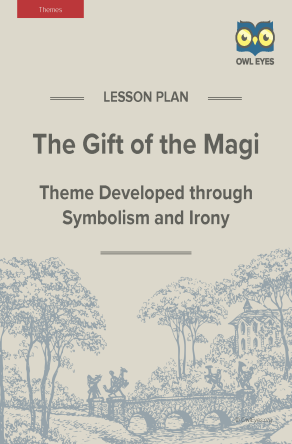The Gift of the Magi Themes Lesson Plan
- 19 pages
- Subject: Irony, Literary Devices, Symbols, Themes, Lesson Plans and Educational Resources
- Common Core Standards: RL.9-10.1, RL.9-10.2, RL.9-10.5, SL.9-10.1
- Grade Levels: 7, 8, 9, 10
Product Description
This lesson focuses on symbolism and situational irony in O. Henry's short story “The Gift of the Magi,” particularly in regard to the plot and the characterizations of Jim and Della Young. Students will identify examples of the two literary elements in the text and interpret the ideas they communicate. By analyzing symbolism and situational irony in the narrative, students will be better able to describe the story’s major theme.
Skills: close reading, analyzing passages in a text for implied meaning, supporting literary analysis with textual evidence, drawing themes from a text
Learning Objectives: By the end of this lesson, students will be able to
- define and explain symbolism and situational irony as literary devices
- identify symbols in the story and describe the ideas they communicate
- explain why the conclusion of the story is an example of situational irony
- determine the main theme in the story and describe how it is developed through symbolism and situational irony
About This Document
Owl Eyes lesson plans have been developed to meet the demanding needs of today’s educational environment and bridge the gap between online learning and in-class instruction. The main components of each plan include the following:
- An introduction to the text
- A step-by-step guide to lesson procedure
- Previous and following lesson synopses for preparation and extension ideas
- A collection of handouts and worksheets complete with answer keys
Each of these comprehensive, 60-minute plans focus on promoting meaningful interaction, analytical skills, and student-centered activities, drawing from the Common Core Standards for English Language Arts and the expertise of classroom teachers.
Introduction to the Lesson
Known by his pen name “O. Henry,” William Sydney Porter wrote hundreds of short stories that were published in magazines and newspapers of his day and printed in collections of his work. “The Gift of the Magi” is undoubtedly Porter’s most famous story. First published as “Gifts of the Magi” in the New York Sunday World two weeks before Christmas in 1905, the story re-appeared in 1906 as “The Gift of the Magi,” collected in The Four Million, a volume of O. Henry’s short stories set in New York City.
The plot of the story is well-known, especially its ironic conclusion. Jim and Della, a young married couple who love each other very much, live in poverty in New York City. As Christmas nears, Della secretly sells her most valued possession—her long beautiful hair—to buy Jim a fine chain for the pocket watch he treasures. When Della gives her present to Jim, she finds out that he has secretly sold his watch to buy her the expensive combs she has often admired. Their costly Christmas gifts are useless, for the time being at least, but in their sacrifices, Jim and Della give each other the greatest of gifts: unselfish love. Like that of the Magi, the three wise men who brought gifts to the Christ child, Jim and Della’s devotion expresses the true meaning of Christmas.
Since its initial publication, “The Gift of the Magi” has seldom waned in popularity. It is included in many anthologies of American literature and has been adapted for the stage and screen, in the United States and abroad. The story also has made its way into American popular culture, with versions of the tale appearing in episodes of television programs and in musical productions. Although numerous literary critics have dismissed the artistic value of O. Henry’s stories, many place “The Gift of the Magi” among the best Christmas stories ever written.
Worksheet Excerpt: Analyzing Symbolism and Situational Irony in “The Gift of the Magi”
Working as a group, discuss the following questions and record your answers on the handout. Refer to the text on Owl Eyes as you discuss and answer the questions. Choose one member of your group to highlight passages in the text that suggest symbolism and situational irony and write an annotation for each passage explaining how your group interprets ideas in the passage. As each annotation is being written, monitor the content to make sure the annotation accurately and thoroughly expresses the analysis of your group.
-
How does the narrator describe Della’s long hair and Jim’s watch? Include some details from the text in your answer.
-
Why would Jim’s watch have great sentimental value to him? In what ways does Della’s hair have more than monetary value to her? Include details from the text to support your answer.
-
Why does Della sell her long hair to Madame Sofronie? Why does Jim sell his watch? What do Jim and Della buy after selling their possessions? How are their purchases described? Include some details from the text in your answer.
-
Considering why Della and Jim sell their treasured possessions, what might their actions symbolize? What are several ideas suggested by their actions and the gifts they buy for each other?
-
On Christmas Eve, Jim comes home to find that Della’s long hair is gone. Explain what occurs in the scene and why it is an example of situational irony.







